 |
Natural Heritage II |
 |
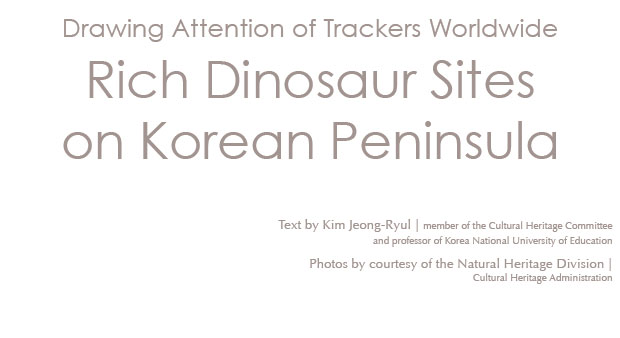 |
 |
 |
 |
 |
Since the American farm boy Pliny Moody happened to plough up a slab of rock bearing small three-toed footprints in 1802,
numerous dinosaur bones and tracks have been discovered around the world to inspire academic research as well as fictional imagination about the extinct terrestrial animals.
In the United States the first significant study of dinosaur fossil tracks is attributed to Edward Hitchcock in the 1830s.
|
 |
Korea emerged on the world map of dinosaur remains much later in 1982, when Prof. Yang Seung-young published a treatise on dinosaur footprints in Goseong, South Gyeongsang
Province. The Korean peninsula has since been known as a trove of Cretaceous dinosaur track sites.
|

1. A quadruped sauropod's trackway at Deongmyeong-ri, Goseong-eup, Goseong County, South Gyeongsang Province; Natural Monument
|
World' s Richest Trackways
Korea has the world' s most densely concentrated
footprints of dinosaurs and birds along its south coast in Goseong County. In his article contributed to National Geographic in 1992, Dr. Martin G. Lockley, a world renowned paleontologist
at the University of Colorado, described
the massive deposits of dinosaur tracks stretching along the coast of Samcheonpo in Goseong County by saying: "We find the three-toed tracks of an unknown theropod in a run. Then we reach a chaotic patch of ancient mud. It looks like a trampled circus ground, pocked with footprints of sauropods." He added, "Samcheonpo bay was so named because of its numerous tiny inlets. One can hardly walk here without stepping on dinosaur footprints."
Given this might have been a bit of an overstatement,
dinosaur researchers around the world admit Goseong is among the most fascinating
sites for dinosaur tracking. The vast expanse
of petrified sediment here is designated Natural Monument.
Tracks of theropods (the mostly bipedal carnivorous
dinosaurs) are exposed relatively rarely when compared with those of sauropods (the large herbivorous quardupeds with long necks
|
 |
and tails) or ornithopods (bipedal or quardupedal
herbivores). It is because meat-eating dinosaurs
were far outnumbered by plant-eaters and they lived and traveled individually. However, Goseong abounds with theropod footprints. Even more intriguing is that they are in various
forms.
Over 70 percent of dinosaur tracks in Goseong, mostly parallel trails heading in the same direction,
have been confirmed to be those of ornithopods classified into nine different species.
It indicates that the track makers lived in herds, probably in an environment quite favorable
to their plant diet. Goseong also has more varied sauropod tracks than any other region in the world. At least three different species have been confirmed in Hai-myeon alone, suggesting
that several species might have inhabited the Korean peninsula.
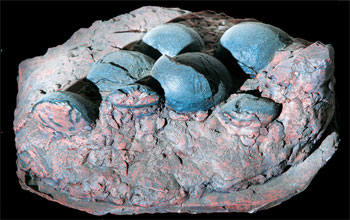
4. A fossilized dinosaur nest with eggs at Bibong-ri, Deungnyang-
myeon, Boseong County, South Jeolla Province; Natural Monument (replica)
|
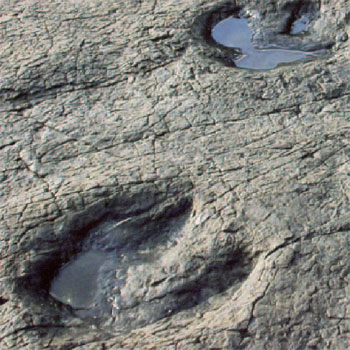
3. A closeup of a sauropod' s footprints at Deongmyeong-ri, Goseong County
|
 |
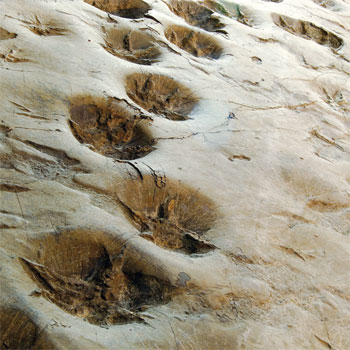
2. Fossilized dinosaur footprints
with extraordinary patterns
of claws and pads at Uhang-ri, Hwangsan-myeon, Haenam County, South Jeolla Province; Natural Monument
|
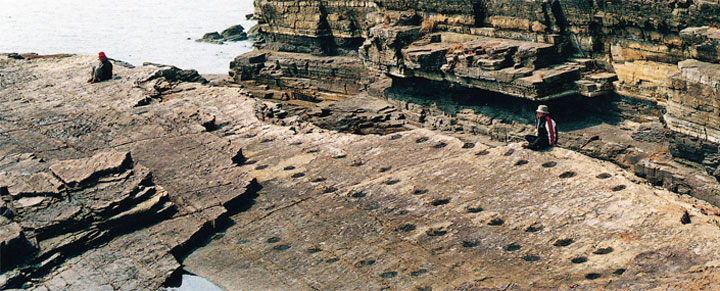
5. Parallel dinosaur footprints at Nangdo-ri, Hwajeong-myeon,
Yeosu City, South Jeolla Province; Natural Monument |
More Dinosaur Habitats
Korea' s another internationally recognized dinosaur
track site is in Uhang-ri, Hwangsan-myeon,
Haenam County, South Jeolla Province. Ichnofossils here have been drawing enormous attention from overseas academic circles as they include footprints of dinosaurs, pterosaurs and birds at the same time, the first such case reported. It is of particular note that Asia' s first known discovery of a large number of pterosaur
footprints was in Uhang-ri.
Also notable is that many of the sauropod footprints here are larger than 100 centimeters square with extraordinary patterns of radial internal ridges. Two footprints of a bird with webbed feet here are the oldest of their kind known in the world. In recognition of its importance
for study of paleogeographic distributions
and the evolution of Mesozoic birds, the Uhang-ri site was designated Natural Monument.
The first international symposium on dinosaurs
in Korea was held here in 1997.
A large number of dinosaur tracks were recently
found in several islands in Hwajeong-myeon, Yosu City, South Jeolla Province. These well-preserved fossils of parallel gaits have been designated Natural Monument. In Seoyu-ri, Hwasun County, also in South Jeolla Province, many dinosaur footprints have been found in good condition, most of them belonging
to meat-eating species. This site was recently named Natural Monument.
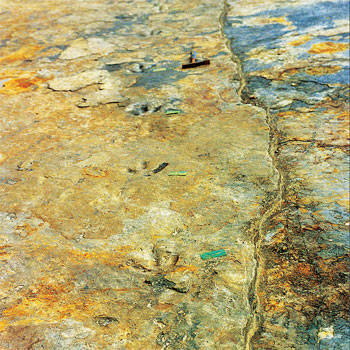 6. Dinosaur tracks at Seoyu-ri, Hwasun, designated Natural Monument of South Jeolla Province. The Hwasun site has the world' s most densely clustered pterosaur tracks and the oldest known footprints of a bird with webbed feet.
6. Dinosaur tracks at Seoyu-ri, Hwasun, designated Natural Monument of South Jeolla Province. The Hwasun site has the world' s most densely clustered pterosaur tracks and the oldest known footprints of a bird with webbed feet.
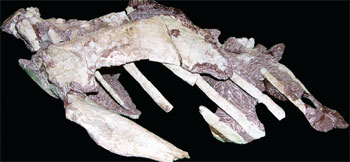 7. Dinosaur bones at Bibong-ri, Boseong County
7. Dinosaur bones at Bibong-ri, Boseong County
|
 |
Discoveries of dinosaur body fossils, including
bones and teeth, have been relatively rare when compared with track fossils in Korea. Well-preserved egg fossils have been found in several locales including Goseong-eup, Goseong County, South Gyeongsang Province;
Bibong-ri, Deungnyang-myeon, Boseong County, South Jeolla Province; and the Sihwa Lake in Gojeong-ri, Hwaseong County, Gyeonggi
Province.
Skeletal remains are scarcely reported as well. A trove of bone fragments, some 30cm long on average, has been discovered in Yusu-ri, Naetong-myeon, Jinju City, South Gyeongsang Province. The site has been designated Natural Monument. Among other sites where fossilized bone fragments have been found are Uhang-ri, Haenam County, South Jeolla Province; and a few sites in South Gyeongsang Province, including Noryang-ri, Yulgok-myeon, Hapcheon County; Dapyeong-ri, Seopo-myeon, Sacheon City; and Galsa-ri, Geumseong-myeon, Hadong
County.
Far rarer are reports on teeth. Fossilized teeth of meat-eating dinosaurs have been found at two localities at Daedo Island in Geumnam-myeon, Hadong County, and Yusu-ri, Naetong-myeon, Jinji City, both in South Gyeongsang Province.
Listing as UNESCO World Heritage
Cretaceous sedimentary deposits teeming with dinosaur tracks are widely distributed throughout
the Korean peninsula. Geological study of Gyeongsang Supergroup started a century ago but it has been only a few decades since systematic research began on the dinosaur and bird tracks imbedded in these levels. Opinions differ over biostratigraphical classification, detailed
definitions of geological eras and their comparison. These are among the issues to be resolved.
In Liaoning Province in northeast China, with a broad distribution of Cretaceous strata biostratigraphically
comparable to Gyeongsang Group, a host of skeletal fossils of feathered dinosaurs as well as amphibians and reptilians have been discovered to attract great attention from international academic communities. There is a high possibility that similar discoveries
might be made on the Korean peninsula, which has been known as a warehouse of Mesozoic
non-marine fossils. This is why more organized research and surveys on Mesozoic strata are needed. Also in order are efforts for better preservation and management of the dinosaur
track sites already discovered.
Since the inscription of Jeju Volcanic Island and Lava Tubes on the UNESCO World Heritage
List last year, expectations have been rising that the dinosaur track sites along the Korean south coast will also be named World Heritage sites.
|
|
 |


